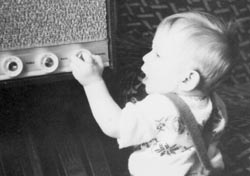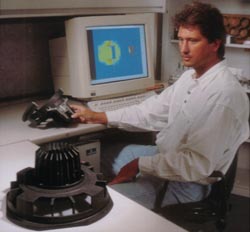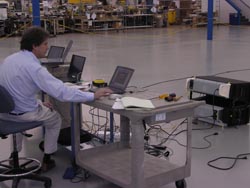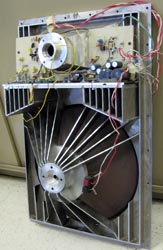Speed Of Sound

NAME: Doug Button
COMPANY: JBL Professional
TITLE: Vice President of Research and Development
OVERTIME: Holding 13 patents with three pending, and having delivered 10 papers on loudspeaker design of which five have been published, in 1997 Button was made a Fellow of the AES. The focus of work is expanding the performance envelope of Professional Audio Transducers.
SCN: What brought you, an electrical engineer educated at Iowa State University, to the professional audio world?
Doug Button: My father was an amateur shortwave radio operator and worked for a small-town AM radio station, so I was exposed to audio and electronics from a very early age. I was tearing apart radios when I was five or six and started building my own speaker designs by the time I was in junior high. I continued building speakers for myself and friends in high school and college. I went to Iowa State because ISU was considered a very good engineering school. I put myself through college with summer jobs and part-time work during the school year. One endeavor in college was a mobile DJ company I started based on speakers I designed and built myself (using JBL and Electo-Voice components). I really didn't know what I was doing until I started reading AES papers by Richard Small and Don Keele.

From an early age, Doug Button had a penchant for making adjustments to sound.
SCN: Since you joined JBL in 1988, you have been responsible for a tremendous amount of the innovations and core transducer technologies found in the company's professional products. Your colleagues have made note of the lightning-fast pace at which an idea travels from your mind into prototype form. How would you describe your design process as it evolves from questions that arise within existing technologies to the prototype phase?DB: The time from when the question is asked until I get the 'flash' isn't instant but when it does come to me it will be largely complete. I then quickly sketch all the required parts by hand. At JBL I have always had the luxury of expert machinists and prototype builders who could take my crude sketches and make exactly what I was thinking. I really have to give a lot of the credit for the 'lightning-fast' pace at which my idea becomes real to the guys who actually make the parts. I finally broke down and started using CAD about 10 years ago and through the use of rapid prototyping technologies I am able to make parts and pursue ideas that were largely impossible with manual methods. The utilization of rapid prototyping technologies, starting here about 10 years ago, has grown considerably, and we can make pretty much anything I can think of in a day or two.

Button "finally broke down and started using CAD about 10 years ago," and through the use of rapid prototyping technologies he is able to make parts and pursue ideas that were largely impossible with manual methods.
SCN: Your R&D role also has a public face, wherein you serve as a panel speaker at AES and other events. As such, you're known as a great "translator" of technical information for a broad audience. Have you found that it is becoming increasingly important to speak the language of the "layperson" as the demand for pro audio expands beyond the core group of experts?DB: I have always felt the best way to really understand something is to teach it. If you really understand something well you should be able to explain it in lay terms. I have always enjoyed 'translating' complex things into simple terms. It actually helps me understand them. I find this is particularly valuable in brainstorming with non-technical people. If I weren't an engineer, I would be a teacher. There is something deeply gratifying in seeing someone 'get it' and share your excitement for some subject or technology. Being able to put things into simple terms also helps sell a technical idea. Part of the success of any engineer is convincing someone your idea has value.

Those who find JBL's rooftop testing to be a bit unconventional might find solace in this image of Button making gated ground plane measurements on the Crown factory floor.
I do believe there is an increasing role for education in audio because such there is a waning interest in analog and basic physics principles. Everyone is interested in digital. While digital methods are great for solving problems and making things better, the fundamental problems are all analog. I started a speaker design class at USC a few years ago. We were seeing that all the college graduates that we would interview for positions at JBL would have a great interest in digital signal processing (DSP), but little knowledge of acoustics or how loudspeakers even worked. I was and still am particularly concerned that loudspeaker design will become commoditized and real understanding will be lost in time.
A daily selection of the top stories for AV integrators, resellers and consultants. Sign up below.
SCN: You've been quoted as saying that the large scale of testing and measurement central to your R&D work requires a bit of "guerilla engineering"; could you elaborate on this?
DB: What I meant by it is that with a very large loudspeaker system you cannot measure it in an anechoic chamber. The anechoic chamber being the traditional battlefield, and making measurements in other environments being the unconventional 'guerilla' approach. Additionally, there are failure modes and misbehaviors of loudspeakers that are not uncovered with traditional acoustical measurements or within the confines of AES or IEC standards. We find ourselves constantly inventing new tests to completely capture loudspeaker (mis)behavior.

Button will admit that he is most proud of the EON design, the first prototype for which is shown here.
The craziest place we ever tested a loudspeaker was... Some people think it's a bit silly that we do a lot of testing on the roof of our building, but it in fact is a great half space. I guess I would say Cal Perkins' back yard when we were developing EON 14 years ago. We used his patio as a ground plane and a TEF12. His shrubs made great diffusers/absorbers.
Past achievements in loudspeaker design... EON is the design I am most proud of. It all came to me instantly. I have always seen it as the only true holistic loudspeaker design. There is no clear line between the transducers, the enclosure, and the electronics as is typically seen even today. They are all intertwined with the aluminum baffle serving as the single piece that integrates the whole.
The AVNetwork staff are storytellers focused on the professional audiovisual and technology industry. Their mission is to keep readers up-to-date on the latest AV/IT industry and product news, emerging trends, and inspiring installations.
